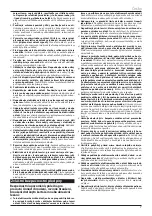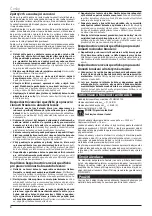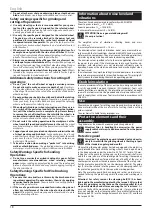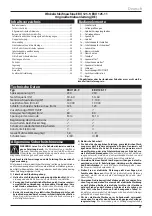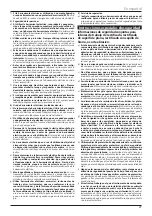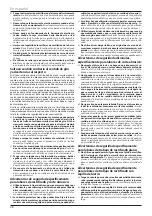
English
17
c)
Prevent unintentional starting. Ensure the switch is in the
off‑position before connecting to power source and/or battery
pack, picking up or carrying the tool.
Carrying power tools with
your finger on the switch or energising power tools that have the
switch on invites accidents.
d)
Remove any adjusting key or wrench before turning the power
tool on.
A wrench or a key left attached to a rotating part of the
power tool may result in personal injury.
e)
Do not overreach. Keep proper footing and balance at all times.
This enables better control of the power tool in unexpected situa-
tions.
f)
Dress properly. Do not wear loose clothing or jewellery. Keep
your hair, clothing and gloves away from moving parts.
Loose
clothes, jewellery or long hair can be caught in moving parts.
g)
If devices are provided for the connection of dust extraction
and collection facilities, ensure these are connected and prop‑
erly used.
Use of dust collection can reduce dust-related hazards.
4) Power tool use and care
a)
Do not force the power tool. Use the correct power tool for your
application.
The correct power tool will do the job better and safer
at the rate for which it was designed.
b)
Do not use the power tool if the switch does not turn it on and
off.
Any power tool that cannot be controlled with the switch is
dangerous and must be repaired.
c)
Disconnect the plug from the power source and/or the battery
pack from the power tool before making any adjustments,
changing accessories, or storing power tools.
Such preventive
safety measures reduce the risk of starting the power tool acciden-
tally.
d)
Store idle power tools out of the reach of children and do not
allow persons unfamiliar with the power tool or these instruc‑
tions to operate the power tool.
Power tools are dangerous in the
hands of untrained users.
e) M
aintain power tools. Check for misalignment or binding of
moving parts, breakage of parts and any other condition that
may affect the power tool’s operation. If damaged, have the
power tool repaired before use.
Many accidents are caused by
poorly maintained power tools.
f)
Keep cutting tools sharp and clean.
Properly maintained cutting
tools with sharp cutting edges are less likely to bind and are easier
to control..
g)
Use the power tool, accessories and tool bits etc. in accordance
with these instructions, taking into account the working con‑
ditions and the work to be performed.
Use of the power tool for
operations different from those intended could result in a hazard-
ous situation.
5) Service
a)
Have your power tool serviced by a qualified repair person us‑
ing only identical replacement parts.
This will ensure that the
safety of the power tool is maintained.
Special Safety Instructions
Collective Safety Warnings for Grinding,
Sanding, Wire Brushing and Abrasive Cutting‑
Off Operations:
a)
This power tool is intended to function as a grinder, sander,
wire brush and cut‑off tool. Read all safety warnings, instruc‑
tions, illustrations and specifications provided with this power
tool.
Failure to follow all the instructions may result in electric
shock, fire and/or serious injury.
b)
This power tool is not suitable for polishing work.
Operations
for which the power tool was not designed may create a hazard
and cause personal injury.
c)
Do not use accessories which are not specifically designed and
recommended by the tool manufacturer.
Just because the acces-
sory can be attached to your power tool, it does not assure safe
operation.
d)
The rated speed of the accessory must be at least equal to the
maximum speed marked on the power tool.
Accessories running
faster than their rated speed can break and fly apart.
e)
The outside diameter and the thickness of your accessory must
be within the capacity rating of your power tool.
Incorrectly
sized accessories cannot be adequately guarded or controlled.
f)
The arbour size of wheels, flanges, backing pads or any other
accessory must properly fit the spindle of the power tool.
Ac-
cessories with arbour holes that do not match the mounting hard-
ware of the power tool will run out of balance, vibrate excessively
and may cause loss of control.
g)
Do not use a damaged accessory. Before each use inspect the
accessories such as abrasive wheels for chips and cracks, back‑
ing pads for cracks, tear or excess wear, wire brushes for loose
or cracked wires. If power tool or accessory is dropped, inspect
for damage or install an undamaged accessory. After inspect‑
ing and installing an accessory, position yourself and bystand‑
ers away from the plane of the rotating accessory and run the
power tool at maximum no‑load speed for one minute.
Dam-
aged accessories will normally break apart during this test time.
h)
Wear personal protective equipment. Depending on the ap‑
plication, use face shield, safety goggles or safety glasses. As
appropriate, wear a dust mask, hearing protectors, gloves and
a workshop apron capable of stop‑ping small abrasive or work‑
piece fragments.
The eye protection must be capable of stopping
flying debris generated by various operations. The dust mask or
respirator must be capable of filtering particles generated by your
operation. Prolonged exposure to high intensity noise may cause
hearing loss.
i)
Keep bystanders a safe distance away from work area. Anyone
entering the work area must wear personal protective equip‑
ment.
Fragments of workpiece or of a broken accessory may fly
away and cause injury beyond immediate area of operation.
j)
Hold the power tool by insulated gripping surfaces only when
performing an operation where the cutting accessory may con‑
tact hidden wiring or its own cord.
Cutting accessory contacting
a “live” wire may make exposed metal parts of the power tool “live”
and shock the operator.
k)
Position the cord clear of the spinning accessory.
If you lose con-
trol of the power tool, the cord may be cut or snagged and your
hand or arm may be pulled into the spinning accessory.
l)
Never lay the power tool down until the accessory has come to
a complete stop.
The spinning accessory may catch the surface
and pull the power tool out of your control.
m)
Do not run the power tool while carrying it at your side.
Acci-
dental contact with the spinning accessory could snag your cloth-
ing, pulling the accessory into your body.
n)
Regularly clean the power tool’s air vents.
The motor’s fan will
draw the dust inside the housing and excessive accumulation of
powdered metal may cause electrical hazards.
o)
Do not operate the power tool near flammable materials.
Sparks could ignite these materials.
p)
Do not use accessories that require liquid coolants.
Using water
or other liquid coolants may result in electrocution or shock.
Kickback and Related Warnings
Kickback is a sudden reaction to a pinched or snagged rotating wheel,
backing pad, brush or any other accessory. Pinching or snagging causes
rapid stalling of the rotating accessory which in turn causes the uncon-
trolled power tool to be forced in the direction opposite of the accesso-
ry’s rotation at the point of the binding.
For example, if an abrasive wheel is snagged or pinched by the work-
piece, the edge of the wheel that is entering into the pinch point can dig
into the surface of the material causing the wheel to climb out or kick
out. The wheel may either jump toward or away from the operator, de-
pending on direction of the wheel’s movement at the point of pinching.
Abrasive wheels may also break under these conditions.
Kickback is the result of power tool misuse and/or incorrect operating
procedures or conditions and can be avoided by taking proper precau-
tions as given below.
a)
Maintain a firm grip on the power tool and position your body
and arm to allow you to resist kickback forces. Always use an
auxiliary handle, if provided, for maximum control over kick‑
back or torque reaction during start‑up.
The operator can con-
trol torque reactions or kick-back forces, if proper precautions are
taken.
b)
Never place your hand near the rotating accessory.
Accessory
may kickback over your hand.
c)
Do not position your body in the area where power tool will
move if kickback occurs.
Kick-back will propel the tool in direction
opposite to the wheel’s movement at the point of snagging.
d)
Take special care when working corners, sharp edges etc. Avoid
bouncing and snagging the accessory.
Corners, sharp edges or
bouncing have a tendency to snag the rotating accessory and
cause loss of control or kickback.
Summary of Contents for EBU 125-11
Page 3: ...3...
Page 4: ...4 1 2 2 3 4 5 6 7a 7b 8 8 9 9 10 11 12 13 14 15 16 16 17 19...
Page 5: ...5 7a 7b 8 5 9...
Page 32: ...o 32 RCD RCD 3 a 4 a 5 a a...
Page 33: ...o 33 a...
Page 46: ...46...
Page 47: ...47...





